MONOPHASIC LIQUID DOSAGE FORMS
MONOPHASIC LIQUID DOSAGE FORMS. SOLUTION:. “A solution is a liquid-preparation that contains one or more soluble chemical substances dissolved in a specified solvent.” Advantages Immediately available for absorption
Share Presentation
Embed Code
Link
Download Presentation
- agents
- colouring agents
- 000 parts
- coal tar
- liquid dosage forms
- 100 parts slightly soluble

otylia + Follow
Download Presentation
MONOPHASIC LIQUID DOSAGE FORMS
An Image/Link below is provided (as is) to download presentation Download Policy: Content on the Website is provided to you AS IS for your information and personal use and may not be sold / licensed / shared on other websites without getting consent from its author. Content is provided to you AS IS for your information and personal use only. Download presentation by click this link. While downloading, if for some reason you are not able to download a presentation, the publisher may have deleted the file from their server. During download, if you can't get a presentation, the file might be deleted by the publisher.
Presentation Transcript
- MONOPHASIC LIQUID DOSAGE FORMS
- SOLUTION: • “A solution is a liquid-preparation that contains one or more soluble chemical substances dissolved in a specified solvent.” • Advantages Immediately available for absorption Useful for hygroscopic drugs which must be administered as a solution • Disadvantages Less stable Incompatibility is faster Bacterial contamination
- A. Aqueous liquids: Water Purified Water Water for injection Sterile water for injection Bacteriostatic water for injection B. Oils &oily materials: Animals source…pig fat Vegetable Source…corn,cotton Mineral Source…liquid paraffin Synthetics….ethyl oleate C. Hydroxylated Compounds: Ethanol Propylene Glycol D. Hydro-alcoholic Mixtures E. Modern Vehicles: Dioxalanes Solvent for aerosol sprays Dimethylecetamide Solvents used
- -Vehicle for the internal Use 1. Purified Water 2.Aromatic Water a. Chloroform Water b. Peppermint Water c. Cinnamon Water d. Dill Water - vehicles for external use Isopropyl myristate Liquid Paraffin -vehicles for extraction Isopropyl Alcohol Acetone
- Formulation Consideration • 1) Solubility a) pH b) Cosolvency c) Solubilization d) Complexation e) Hydrotrophy f) Chemical modification of the drug molecule 2) Preservation a) Preservatives b) Antioxidants c) Reducing agents d) Synergists 3) Organoleptic consideration a) Sweetening agents b) Flavoring agents c) Coloring agents d) Viscosity control e) Overall appearance 4) Stability a) Chemical stability b) Physical stability
- 1.SOLUBILITY • Expression of solubility According to Indian Pharmacopoeia Descriptive Phrase - Approximate quantities(ml) of solvent by volume for 1 part (1 gm) of solute by weight Very soluble - less than 1 part Freely soluble - from 1 to 10 parts Soluble - from 10 to 30 parts Sparingly soluble - from 30 to 100 parts Slightly soluble - from 100 to 1000 parts Very slightly soluble - from 1000 to 10,000 parts Practically insoluble - more than 10,000 parts
- a. pH A large number of drugs are either weak acids or weak bases. The solubility of these agents can be markedly influenced by the pH of the environment • Weak Acid pH = pKa + log (ionised ) /(un ionised) pH = pKa + log (base) / (acid) Weak Base pH=pKa +log (unionised) / (ionised) pH = pKa+ log( base )/(acid) b. COSOLVENCY Weak electrolytes and nonpolar molecules frequently have poor water solubility. These types of solutes are more soluble in a mixture of solvents than in one solvent alone. This phenomenon is known as cosolvency.
- c. DIELECTRIC CONSTANT One property of a solvent system is its dielectric constant. The dielectric constant of a solvent can be defined as the ratio of the capacitances of a capacitor filled with the solvent and air respectively. d. SOLUBILIZATION spontaneous increase of solubility of a poorly water-soluble solute molecules into an aqueous solution of surface active agents (or surfactants) in which a thermodynamically stable solution is formed.
- e. COMPLEXATION Solubility of a compound may be increased by complexing with a complexing agent. e.g. solubility of para amino benzoic acid (PABA) may be increased by complexing with caffeine f. HYDROTROPHY The term hydrotrophy has been used to designate the increase in solubility in water of various substances due to the presence of large amounts of additives. g. CHEMICAL MODIFICATION OF DRUG Poorly soluble drugs are chemically modified into water soluble derivatives.
- 2.PRESERVATION a.Preservatives Some pharmaceutically useful preservative Class -------Preservative ------Usual concentration (%) -Acidic Phenol - 0.2 - 0.5 Chlorocresol - 0.05 - 0.1 -Neutral Chlorbutanol - 0.5 Benzyl alcohol - 1.0 -Mercurial Thiomersal - 0.001 - 0.1 Nitromersol - 0.001 - 0.1 -Quarternary ammonium compoundsBenzalkonium chloride - 0.004 - 0.02 Cetylpyridinium - 0.01 - 0.02
- b. Antioxidants An antioxidant is a molecule that inhibits the oxidation of other molecules c. Reducing agent A reducing agent (also called a reductant or reducer) is the element or compound in a reduction-oxidation reaction that donates an electron to another species however, since the reducer loses an electron we say it is "oxidized". This means that there must be an "oxidizer"; because if any chemical is an electron donor (reducer), another must be an electron recipient (oxidant).
- 3.ORGANOLEPTIC ADDITIVESa. Colouring Agents • Colouring Agents generally used in case of cosmetic preparations. • The second reasons is to distinguish one product from the products. A third reason is to distinguish the preparation being administered • Classification- 1.natural colouring agents-plant -animal -minerals 2.syntetic -coal tar
- 1. Natural Colouring Agents: • Plants: • Many plants contain colouring agents which may be extracted. and used as colorant. • Some Examples are: a. Chlorophyll-green b. Annatto seeds-yellow to orange
- Animal:- Cochineal: It is an alkaline solution of the soluble Colouring principles caraminic acid of cochineal insects preserved by the addition of.It is very dark purplish red liquid.Minerals: -Mineral colours are termed pigments. -They are used to colour lotions, cosmetics and other preparation for external application. -As they are toxic, their use for internal preparation is forbidden. Ex: Red ferric oxide Yellow Ferric Dioxide
- 2. Synthetic colouring agents • The synthetic colours are coal tar dyes, because many of them are produced from substance obtained from coal-tar. • The certified colours are classified into three groups: • Group I- F.D. and C. Colours used in foods, drugs and cosmetics. • Groups II- The D. and C. Colour used in drug and Cosmetics. • Group III- The External D. and C. Colour.
- b. Flavouring agents • The use of flavour is actually a composite sensation of taste, touch, smell, sound and heat. • There are simply four types of tastes - Sweet - Sour - Salty - Bitter . Similarly there are seven basic odours like - Ethereal , camphoraceous ,Musky, Floral ,Pepperminty ,Pungent ,Putrid
- Classification of flavouring agents Two Types: 1. Natural and 2. Synthetic 1. Natural a. Fruits (Sweet, Sur and Astringent) Citrus Fruits (Orange, Lemon) b . Seeds (Vanilla, Anise, Nutmeg) 2.synthetics Benzaldehyde - Bitter Almond, Cherry pits Decyl Aldehyde - Citrus Flavours (Orange) Cinnamic aldehyde - Cinnamon type
- c. Sweetening agents • Sucrose • Sorbitol (Half Sweet than Sucrose) • Glycerin • Honey • Saccharin Sodium (300-550 times) • Cyclametaes (30 times sweeter than sucrose) • Aspartame
- d.Viscosity control Used to increase palatability and pourability Examples of viscosity controlling agents are -PVP -cellulose derivatives e.General apperance depends on colour and clarity
- 4.STABILITY a. Chemical stability Ex- effect of amino acids on stability of aspirin in propylene glycol solutions. b. Physical stability Oral liquids are stable if it retains viscosity,colour,taste and odour throughout its shelf life
- liquid dosage forms Monophasic (homogeneous solutions in which solute and solvent cannot be differentiated) Biphasic Emulsions suspensions External Internal Draughts Drops Linctus Syrups Elixirs mixtures Liquids for oral cavities Liquids appiled on body cavities Liquids appilied on skin Douches Enemas Ear drops Nasal drops Inhalants and eye drops Gargles Mouthwashes Throat paints Glycerites Throat spray Liniments Lotions collidions
- ORAL MONOPHASIC DOSAGE FORM • ORAL MONOPHASIC DOSAGE FORM Draughts Drops Linctuses Syrups Elixirs Mixtures
- A. Draughts • It is simple solution (mixture) which contains a single dose. • Each dose is sent in separate bottle.Total volume is 50 ml. • It is essential to be labelled with storage conditions on draughts. • It is given very early expiry date (48 hours). Examples: 1.Ipecacuanha emetic draughts-BPC (Treatment of poison) 2. Paraldehyde draughts- Oxidized to acetic acid and cause death Do not use, if the solution is discolored.
- Classification of mixtures • Mixtures containing soluble substances Eg: Carminative mixtures • Mixtures containing diffusible solids Eg: Bismuth, magnesium carbonate • Mixtures containing in diffusible solids Eg: Salicylic acid, quinine salicylate • Mixtures containing precipitates forming liquid Eg: potassium iodide
- D . SYRUPS: • “It is concentrated aqueous solution of sucrose mixed with solution of medicaments and others additives.” • Generally syrup is prepared by sucrose but is partly replaced by dextrose or other polyhydric alcohols to reduce crystallisation of sucrose or to increase solubility of medicaments and other additives. • Consists of 85% sugars • 2 types of syrups Non medicated syrup Medicated syrup
- FORMULATION OF SYRUP • Sugar-85% • Anti microbial preservatives(0.1-0.2%) benzoic acid ,sodium benzoate • Flavorant • colorant Example- Active drug – 5ml Other drug solids -3ml Glycerin - 15ml Sucrose -25g Ethanol - 95%qs Purified water - 100ml
- Function of Syrups • Sweetening agent • Good antioxidant • Preservatives • Demulcents and • soothing agent • EXAMPLES OF SYRUPS: Codeine phosphate syrup Squill syrup
- Syrups are used for formulating Antibiotics Antitussives Antihistamines Vitamins Analgesic/antipyretic PREPARATION OF SYRUP – 1.Solution with heat: For non-volatile, thermostable drugs 2.Agitation without heat: For volatile, thermolabile drugs 3.Addition of medicating liquid to syrup: For liquid medicaments such as extracts, tinctures 4.Percolation:
- E. ELIXIRS Elixirs are clear, pleasantly-flavoures, sweetened Hydro alcoholic liquid intended for oral use. 2 types of elixirs • Medicated elixir • Non medicated elixir
- ADDITIVES 1.Chemical Stabilizers: pH Adjustment Sequestering agents- like EDTA 2.Colouring Agents: Amaranth Compound Tartrazine 3.Flavouring Agents: Lemon spirit ,Compound orange spirit 4.Sweetening Agents: Invert Syrup, Sodium Sachharin 5. preservatives: 20% Alcohol as vehicle Propylene glycol
- Formulation of phenobarbital elixir phenobarbital - 4g orange oil - 0.25ml propylene glycol - 100ml alcohol - 200ml sorbitol solution - 600ml colour - qs purified water - 1000ml EXAMPLES- Chloral Elixir pediatric Paracetamol Elixir Ephedrine Elixir Phenobarbitone Elixir
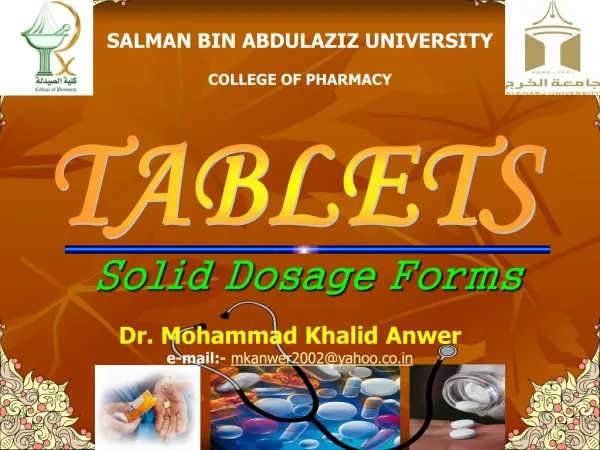
Solid Dosage Forms
SALMAN BIN ABDULAZIZ UNIVERSITY COLLEGE OF PHARMACY. TABLETS. Solid Dosage Forms. Dr. Mohammad Khalid Anwer e-mail:- mkanwer2002@yahoo.co.in. Tablets.
2.52k views • 84 slides

Liquid Dosage Forms
1.Pharmaceutical Solutions. Solutions are: Dosage forms prepared by dissolving the active ingredient(s) in an aqueous or non aqueous solvent. . Solutions can be formulated for different routes of administration Orally: Syrups, elixirs, dropsIn mouth and throat: Mouth washes, gargles, throat sprays. In body cavities: Douches, enemas, ear drops, nasal sprays. On body Surfaces: Collodions, lotions. .
2.45k views • 66 slides
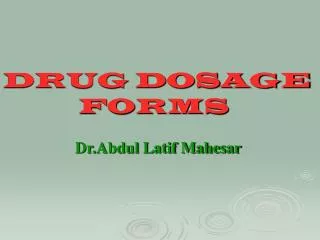
DRUG DOSAGE FORMS
DRUG DOSAGE FORMS. Dr.Abdul Latif Mahesar. DRUG DOSAGE FORMS (DRUG PREPARATIONS ) - Tablets , Capsules, Powder - Syrups, suspensions , Elixer - Aqueous suspension, Emulsion - Ointment , Lotion, cream - Suppository, pessary Aerosols Injections. ,. DRUG DOSAGE FORMS cot’d Tablet:
1.52k views • 18 slides

Liquid Dosage Forms
Liquid Dosage Forms. 1. Pharmaceutical Solutions. Solutions are: Dosage forms prepared by dissolving the active ingredient(s) in an aqueous or non aqueous solvent. . Solutions can be formulated for different routes of administration Orally : Syrups, elixirs, drops
1.59k views • 67 slides
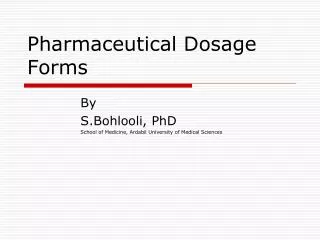
Pharmaceutical Dosage Forms
Pharmaceutical Dosage Forms . By S.Bohlooli, PhD School of Medicine, Ardabil University of Medical Sciences. Oral Tablets Capsules Solutions Syrups Elixirs Suspensions Magmas Gels Powders. Sublingual Tablets Troches and Lozenges Parenteral Solutions Suspensions Conjunctival
1.78k views • 36 slides
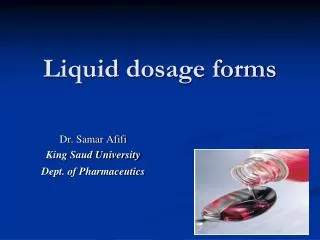
Liquid dosage forms
Liquid dosage forms. Dr. Samar Afifi King Saud University Dept. of Pharmaceutics. Introduction. Lecture 1. Monophasic liquid D.F Solutions. Polyphasic liquid D.F. Suspensions. Colloids. Liquid dosage forms. Aqueous solutions. Non-aqueous solutions. Emulsions. Liquid dosage forms.
6.45k views • 25 slides

TYPES OF DOSAGE FORMS
TYPES OF DOSAGE FORMS. Types of dosage forms:. Definition: Dosage forms are the means by which drug molecules are delivered to sites of action within the body. The need for dosage forms: 1- Accurate dose. 2- Protection e.g. coated tablets, sealed ampules. 3- Protection from gastric juice.
9.19k views • 48 slides

Liquid dosage forms
Liquid dosage forms. Lecture 2. Solubility. ● To hasten dissolution, a pharmacist may employ one of several techniques such as applying heat, reducing the particle size of the solute, using a solubilizing agent, or subjecting the ingredients to vigorous agitation.
665 views • 24 slides

SEMISOLID DOSAGE FORMS
SEMISOLID DOSAGE FORMS. SEMISOLID DOSAGE FORMS. Include drug delivery systems and dosage forms intended to be applied to the skin. Ointments. Pastes. Creams. Gels. Preparations are applied to the skin for: Physical effects skin protection, lubricants, emollients, drying agents
3.22k views • 59 slides

STERILE DOSAGE FORMS
STERILE DOSAGE FORMS. Dr. Basavaraj K. Nanjwade M. Pharm., Ph. D Department of Pharmaceutics Faculty of Pharmacy Omer Al- Mukhtar University Tobruk , Libya. E-mail: nanjwadebk@gmail.com. CONTENTS. Introduction Routes of parenteral administration Components of parenteral products
1.64k views • 37 slides

Compounding special dosage forms
M. Ansari Pharm D, PhD Associate Professor of Pharmaceutics. Compounding special dosage forms. Packaging, Storage and Distribution of Compounded Pharmaceuticals General "Good Compounding Practices" for Nonsterile Products Compounding Gels Compounding Capsules Troches and Lozenges
1.05k views • 79 slides

Solid Dosage Forms (Tablets)
Solid Dosage Forms (Tablets). Dr. Basavaraj K. Nanjwade M. Pharm., Ph. D Department of Pharmaceutics Faculty of Pharmacy Omer Al- Mukhtar University Tobruk , Libya. E-Mail: nanjwadebk@gmail.com. Content of Tablets. Definition Advantages and disadvantages Types of tablets
3.72k views • 56 slides

Standardization of Prescribing and Using Oral Liquid Dosage Forms (OLDFs)
Standardization of Prescribing and Using Oral Liquid Dosage Forms (OLDFs) Moslem Movahed Department of Medical Management of Province of Qom Social Security Organization, Iran, Islamic Republic of. Standardization of Prescribing and Using Oral Liquid Dosage Forms (OLDFs)
229 views • 13 slides

PHT 3101: Liquid and semisolid dosage forms
PHT 3101: Liquid and semisolid dosage forms. Liquid and semisolid dosage forms. What to cover : Solutions Emulsions Suspension Ophthalmic , otic and nosal preparations Ointments ,creams and gels Suppositories and inserts QA(QC and cGMP ). Course aim.
1.02k views • 33 slides
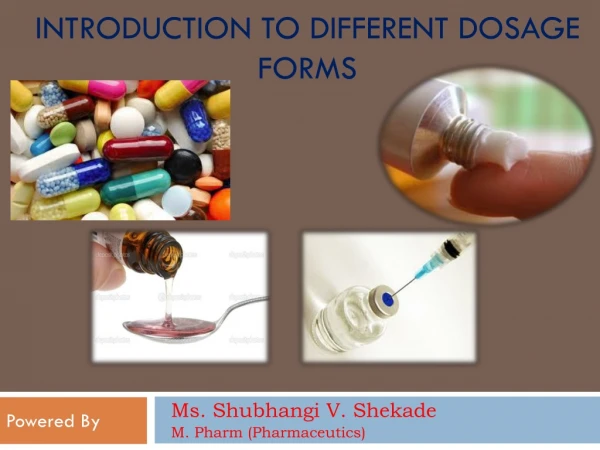
INTRODUCTION TO DIFFERENT DOSAGE FORMS
INTRODUCTION TO DIFFERENT DOSAGE FORMS. Ms. Shubhangi V. Shekade. Powered By. M. Pharm (Pharmaceutics). Drug. Drug may be defined as an agent or substance, intended for use in the diagnosis, mitigation, treatment, cure or prevention of disease in human beings or animals.
2.8k views • 160 slides

LIQUID DOSAGE FORMS
LIQUID DOSAGE FORMS. PART II. PREPARATION OF MIXTURES. Rule preparation of mixtures:. At preparation of dosage forms hold to the set procedure of dissolution and mixing of medications taking into account their physical and chemical properties.
381 views • 12 slides

Standardization of Prescribing and Using Oral Liquid Dosage Forms (OLDFs)
Standardization of Prescribing and Using Oral Liquid Dosage Forms (OLDFs) Moslem Movahed Department of Medical Management of Province of Qom Social Security Organization, Iran, Islamic Republic of. Standardization of Prescribing and Using Oral Liquid Dosage Forms (OLDFs)
153 views • 13 slides

LIQUID DRUG DOSAGE FORMS
LIQUID DRUG DOSAGE FORMS. Notes for Students
397 views • 20 slides

TYPES OF DOSAGE FORMS
TYPES OF DOSAGE FORMS. Types of dosage forms:. Definition: Dosage forms are the means by which drug molecules are delivered to sites of action within the body. The need for dosage forms: 1- Accurate dose. 2- Protection e.g. coated tablets, sealed ampules. 3- Protection from gastric juice.
720 views • 48 slides

Solid Dosage Forms
SALMAN BIN ABDULAZIZ UNIVERSITY COLLEGE OF PHARMACY. TABLETS. Solid Dosage Forms. Dr. Mohammad Khalid Anwer e-mail:- mkanwer2002@yahoo.co.in. Tablets.
1.22k views • 84 slides






















